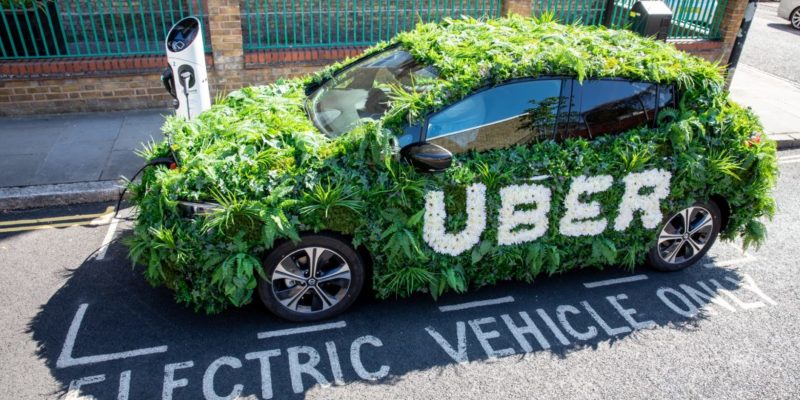Ride-hailing services Uber and Lyft have already provided 5.5 billion rides to more than 50 million users, so the meteoric rise of the young companies is drawing attention on how the transition to electric vehicles will benefit the environment.
In June, Lyft announced it will commit to electrifying 100% of its largely privately owned fleet by 2030, a move that it is undertaking in partnership with the US-based Environmental Defense Fund.
Uber in 2018 launched its “EV Champions” initiative to pilot fleet electrification via a driver-partners program in seven US cities, and has also committed to helping London Uber drivers to make the transition to zero emissions vehicles by 2025.
But what would the benefits be, if all these ride-hailing vehicles are transitioned to electric drivetrains? More than substantial, a new study from the University of California says.
In fact, replacing a ride-hailing car with an electric vehicle delivers three times the environmental benefits, the new study published in Nature Energy on Monday shows.
While there have been a small number of studies into the benefits of electrification of ride-hailing in the past, such as the 2012 Green Move electric-vehicle-sharing trial at the Polytechnic University of Milan, the sample numbers have to date been tiny.
In the case of Green Move which was conducted when the EV market was still very much in its infancy, just four vehicles were used.
The new study by Alan Jenn, who is Professional Researcher at the Institute of Transportation Studies at the university, compares daily travel and charging behaviour or battery electric vehicles (BEVs) with those owned and driven for private use, as well as daily travel of internal combustion engine (ICE) and plug-in hybrid (PHEV) vehicles.
For the California-based study, Jenn drew on empirical data from 400,000 single service BEV trips from one major transport network company (TNC) and 1,000 full-time BEV ride-hail drivers, compared against 118,668 ICE trips from the California Household Travel Survey and PHEV usage from 15,275 respondents in a Plug-in Hybrid & Electric Vehicle (PH&EV) multiyear panel survey.
Jenn found that concerns about the ability of BEVs to provide the same service as ICE and PHEVs due to limited driving range to be unfounded – according to the data, BEVs provided the same level of service as ICE vehicles in regards to numbers of rides and trip distances.
Even better, the study found that because ride-hail vehicles are driven much more than if they were only used for private use (about 190 miles or 305km on average compared to 30 miles or 48km), the benefits in terms of emissions reduction were much higher.
Put simply, the emissions saved from replacing a ride-hail vehicle with an electric car is triple that of replacing a privately owned vehicle, the study found.
“From a purely emissions stand point, we found that even in the most pessimistic scenario, replacing a full-time ride-hailing service vehicle with a BEV yields an emissions reduction three times higher than replacing an average gasoline vehicle in California,” the study reports.
The transition to electric vehicles for ride-hail drivers are especially compelling because of their very low maintenance and energy costs compared to ICE vehicles, Jenn adds.
But because of the higher cost of electric vehicles, as well as different patterns in charger usage (ride-hail BEVS may use a charger from 2-3 times a day), there is a need to consider implications for policy, particularly in regard to infrastructure networks and programs.
“A high travel intensity leads to larger emissions benefits, but also means a greater requirement for the charging and associated infrastructure,” the study says.
“Our analysis indicates that regular PEV users tend to have a lower average utilization of chargers during the hours of the day with a greater TNC utilization.
“However, one of the key draw backs of the analysis is that many of the observed charging events are often based on behaviour that stems from free charging opportunities provided by specific network providers.
“From an economic feasibility perspective, it is unclear whether this programme is sustainable.
“The potential success of adopting electric vehicles requires a balance between the higher upfront cost of the vehicle and the marginal cost with use, which is free in this case study, but has the potential to be more expensive than gasoline—particularly with d.c. fast charging,” the study says.
While ride-hail market still has “tremendous potential for further expansion” according to Jenn, there is another change waiting in the wings for the industry.
Both Uber and Lyft will have big competition on their hands as autonomous driving technology reaches a point where its safety gains regulator approval.
EV juggernaut Tesla plans to launch its own autonomous electric vehicle ride-hailing network, dubbed by CEO and co-founder Elon Musk as “robo-taxis”, and online retail giant Amazon on Friday acquired Zoox, an autonomous startup backed by Australian billionaire Mike Cannon-Brookes.
The merging of ride-hail and autonomous driving technology is all but inevitable. On what timeline these ambitious plans come to full realisation is yet to be seen – nevertheless in terms of emissions and charging infrastructure needs, both will likely have the same result.
Citation:
“Emissions benefits of electric vehicles in Uber and Lyft ride-hailing services”
Author: Jenn, A.
Published in: Nat Energy (2020)
https://doi.org/10.1038/s41560-020-0632-7

Bridie Schmidt is associate editor for The Driven, sister site of Renew Economy. She has been writing about electric vehicles since 2018, and has a keen interest in the role that zero-emissions transport has to play in sustainability. She has participated in podcasts such as Download This Show with Marc Fennell and Shirtloads of Science with Karl Kruszelnicki and is co-organiser of the Northern Rivers Electric Vehicle Forum. Bridie also owns a Tesla Model Y and has it available for hire on evee.com.au.

